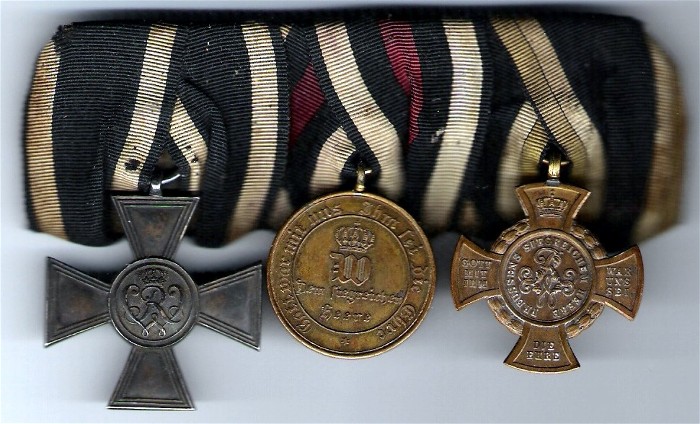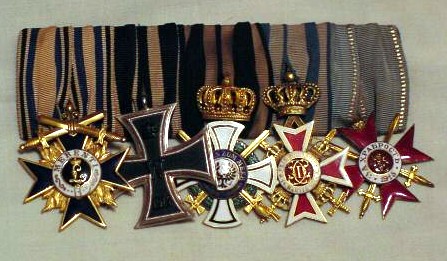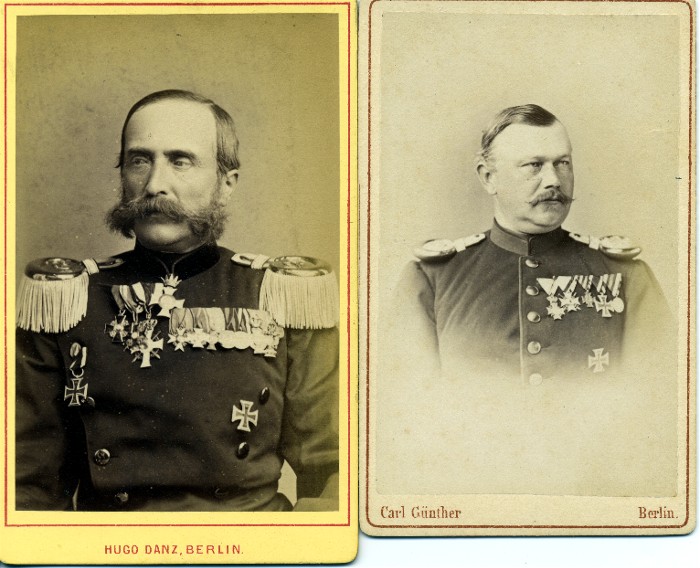
medalnet
-
Posts
897 -
Joined
-
Last visited
-
Days Won
3
Content Type
Profiles
Forums
Blogs
Gallery
Events
Store
Posts posted by medalnet
-
-
I know it is confusing. Even I have a S-W Iron Cross 1st class.
The takeover by J.Wagner is, by the way, common believe. I guess I need to clarify this here. There are some indications that specific toolings were used before by Hossauer and afterwards by J. Wagner.
0 -
OK, just a quick question: If S&W becomes Wagner (W) ca. 1880...... then who was the S&W attributed to Sy & Wagner ca. 1914-18 and often found marking WW1 EK1??
Sorry about the Werner thing...... sometimes the fingers work faster than the brain, or vice versa!
Then...... (OK, more than 1 question)
The example I show in posts #6 & #8 is a known ca. 1866 example. We know the seller stripped an original bar to sell the piece. We know the cross is authentic....... however the ?se is much fatter than the thin examples shown by WildCard! Where does this fit in??????????
As I said, we do not everything. Are there prooven facts about Sy & Wagner being arround during WWI making medals? I do know S W markes on Red Eagle Order Grand Cross Stars. Yet they all have Silver gilt centers. I was always under the impression that the S would stand for "Silver gilt" in order to have a way of seperating Gold and gilt Silver from each other. This was common practice to not mix those by accident.
In reagrds to the 1866 bar. It is possbile, just possible that the bar was assembled later and a later piece was used to complete the bar.
It is a fact that the early pieces Especially those predecessors are hollow made and have small Oesen. Sorry to offer only a scan from a photocopy, but I don't have better pictures. Example a) is the 3rd type "Verdienst um den Staat", b) is the first type "Kriegsverdienst, which we believe to be the initial hollow made type, just like b) is made hollow.
Both crosses have small/thinn Oesen.

 0
0 -
Sorry, I didn't mention: almost all early Prussian Merit crosses have the thin loop. In my experience the later crosses come with those big, more round Oesen.
What would the English term for Oese be, anyway?
0 -
Please, not Werner. Emil August Wagner. Following the literature it was him together with Mr. Sy who bought the Hossauer firm in 1859 - Sy & Wagner.
We do know that the Sy & Wagner firm was eventually taken over by Johann Wagner approx mid 1880th and used from then on the W mark.
Anyway, the evolution of those "Verdienste um den Staat" crosses towards those 'Militaerverdienst" crosses took many steps. Unfortunately not all archive documents have been found or survived to give us 100% closure yet.
The statement about being identical pertains to the same tooling only. In this case Wagner. One can see that the earlier pieces have that destinctive S in Verdienst. The lower part of the S is always closed, yet the S on Wagner variation is open.
The really early ones are those being unmarked. Early pieces of the new 1863/4 style were definetly hollow their forefathers, the "Verdienst um den Staat" crosses. Even silver had more value to a certain point then hourly labor.
For those really wanting to go into detail on those crosses and medals should get their hands on copies of the :"Money Trend" maganzine #3 & #4 from 1995
0 -
...well, since we are at it, a scan from a photo showing a rather narrow Oese:

 0
0 -
...a lunch break makes it possible. As promised the other similar medal bar from: Karl Bernhard von Schenk

 0
0 -
The asking price of this bar is 3200- Euro. It comes cased, with a matching trapezoid ribbon bar. The ribbon bar, case are just as minty-fresh as is the bar I showed. I would be more than happy to pass on the information of the seller to anyone willing to spend the $3800 USD on the set.
Lucky you, I was offered the bar at 6000 Euro's. By the way, I compared the pictures I had received with those Wild Card posted and have to say that they are identical.

 0
0 -
Which yet again, does not fit to the bar shown. I am willing to accept the research/facts that AW may have been a maker pre-1900 however I would contend that the cross on the bar was not made by him, nor is the bar "real".
It is always hard to say by just looking at pictures. Especially with medals. But the bar has a good chance to be real. As a matter of fact, I know somebody with a very similar bar, with the recipients name. It is pretty much identical, yet it is missing the Iron Cross. I will try to find the picture tonight and post it here, too.
0 -
Gentlemen,
To medalnet?s point in post #17, following are pictures of a cross marked ?AW? with a thinner ?se. Is this not the one you were referring to medalnet?
Regards,
Wild Card
Indeed, I did not have the picture handy when I replied yesterday. There are also crosses with even thinner oesen. Thanks Wild Card.
0 -
I have only seen 3 variations:
a) unmarked
b) AW
c) W
Yet, I do disagree with that statement on the wire vs. ball shaped ring attachement. The very early crosses have indeed a more wire shapped ring attachement.
0 -
Great eye, Andreas. How were you able to tell from the photo that the flames are separately attached?
Well, lots of handeling the real pieces. 99% of all 3rd classes in silver gilt are gilt 4th classes anyway.
0 -
Because they do not know any better.........
That is why it is so great that we have forums like this one.
Just take the MVO 4th class with swords that has been gilt after the fact. Original 3rd classes in silver gilt are made exactly the same way their golden brothers are. Just one detail about this are the seperatly attached flames!
0 -
Ebay has been bringing up a lot of bad stuff but also a lot of good stuff.
So, why would somebody try to buy this medal bar? As seen on ebay:
medal bar on ebay item # 6591686391

 0
0 -
This would be one of my favorite medal bar that came home in 2005. all decorations made by Godet in gold. Well, except the iron cross, of course.

 0
0 -
A very nice and rare mini, indeed.
Did you guys see this one on ebay (6238094565)? Very nice, too:

 0
0 -
On more comment and I will let it go:
Friedrich Wilhelm ordered on December 19, 1851, that all people being awarded a medal or order for their jubilee will have device attached to the order showing the number of the particular jubilee.
This should clarify this issue.
0 -
...and not the "65", but:

 0
0 -
Here a little bar with a real "50":

 0
0 -
Collecting is an interesting and exciting hobby. It still can be frustrating if information isn't obtainable.
When I started out - 15 years ago - collecting German orders, decorations and medals I had little, actually absolutely no knowledge about this complex topic. Needless to say that the first 15 pieces, bought from hard earned pocket money, were all fakes.
Looking back to this incident I think I made the right experience. I should have strived for more information. Instead, I just wanted to accumulate as fast as possible all those pretty and interesting medals.
I don't think this should happen to anybody else. Especially since there are so many different sources of information in today's world. The number of publications, books and collectors, even societies, is in any case quite different than 15 or 20 years ago. Getting the right information is way easier these days and makes our hobby more enjoyable. Building a collection does make even more fun, when information is shared in-between collectors.
I would like to make my experience accessible for all those who are not only accumulating their treasures, but looking for the history behind orders, decorations and medals.
Have fun working your way through my ?Web-Space? and always keep in mind, that I am still looking for rare orders , decorations and medals for my own collection. www.medalnet.net
Andreas M. Schulze Ising
0 -
I believe that it is simply wrong to say the grade of Order with a jubilee year attachment had been held in that grade for that long. The only actual "held for 50 years" attachment that I am aware of was the Crown to the Pour le Merite--
and that bears NO year number.
Rick,
you are certainly correct. one should never post things here during work ours being distracted by "more important" things then medals (
 well, is it?)
well, is it?)I believe the regulation in the statues is worded that way, the true meaning is the years served for King/Emperor and counrty!!!
I know of a Red Eagle Order 2nd class with oak leaf and jubilee number "65" given to a priest with a long career in a clerical office at the Prussian state. Holding the order for 65 years would be a real miracle.
0 -
... These "lower grade" orders with long service discs have been neglected by the fakers thus far.
Sadly, as with all things these days, the spiraling upward prices (I can only recall about 6 times last 2 or 3 years a lower grade like this has been offered in any venue) will attract their attention in very short order....
Dear Stogie,
I hate to say this, but all jubilee numbers have been faked. Regardless of medal or order or grade. The best ones I have seen are again those elecrosculptured ones. Most were made in Wuppertal, Germany, as well as down south in Germany. The number of fakes is not that high, but they exist.
I have had a special interest in those numbers and have accumulated a fair number of awards with those numbers, to find out that they follow the same regularity as the orders they are attached to. Each manufacturer had its own "handwritting" and way of finishing them.
Fact is: very rare specialty awards. Imagine holding a red Eagle order for over 50, 60 or even 65 years....
0 -
Absolutly correct. I totally agree with Rick.
Yet, one question: Does anybody have a copy of a Prussian "Ordensliste"? I would be courious to know if those medals were actaully listed in there?
0 -
I may have to translate this article on my web page into English over the upcoming holidays:
http://www.medalnet.net/Red_Eagle_Order_Medal.htm
The Red Eagle medal had no clear rules of how to be awarded. When renewed/reissued on March 10, 1871, 400 examples were ordered through the state chancellery.
Initial awards were made to the guards of the grand head quarters in Berlin. Those were worn on the Hohenzollern ribbon. Wilhelm I. decreed in 1873 that the Red Eagle medals were only to be awarded to those military persons that never participated in a war. Those awards had to be made to enlisted and NCO ranks and only on the orange white ribbon. It was further OK to award the medal to court servants.
Some medals were awarded in 1910 to Prussian citizens, but were disliked by the emperor. Medals were never again awarded for this purpose.
Looking even further back to the initial medal with the FW IV on the reverse it seems to me that this medal was given out as a personal distinction of the emperor, mostly to officials/military personnel serving at court events. But this is just my opinion. Documents have not been seen yet, which underlines the rather personal character of this award.
0 -
Something to look at: Orders and Decorations in their natural habitat:
Groh (the Saxon) and Oberst von Marchtaler (the Wuerttembergiensis)

 0
0


What about this one?
in Russia: Imperial
Posted · Edited by medalnet
Can somebody put a light on this piece, please?! Especially in lieu on the Faberge topic?
[attachmentid=21604]